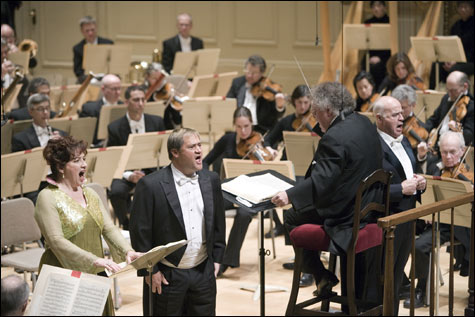Levine’s Berlioz and Wuorinen, Garrick Ohlsson’s Beethoven, the Borromeo’s Shostakovich, the Alloy’s Eagle
By LLOYD SCHWARTZ | February 20, 2007

LA DAMNATION DE FAUST: Berlioz’s “dramatic legend” was electrifying. |
James Levine returned from his winter break with one of the most thrilling BSO concerts of his tenure: Berlioz’s “dramatic legend,” La damnation de Faust. With its dramatic confrontations for its three main characters and picturesque scenic shifts, it’s more than an oratorio; yet with its emphasis on the chorus and its dazzling orchestral colors, it’s not quite an opera. (Although some directors — Sarah Caldwell for one — have found it hard to resist the impulse to see it acted out.) Whatever the genre, it overflows with gorgeously spun-out melodies and vivid dramatic gestures. And the BSO proved it can succeed despite vocalists who aren’t quite up to Berlioz’s heavy demands.Those soloists were American tenor Paul Groves as Faust, the discontented seeker for more than what he feels life has offered him; French mezzo-soprano Yvonne Naef, as the innocent Marguerite, who succumbs to Faust’s passion; and the veteran Belgian bass-baritone José van Dam, as the seductive Mephistopheles. They have good qualifications: the right vocal timbre and style. But though Groves acted with passion, he was stretched beyond his technical range and simply didn’t have some of the notes. Naef’s Ming-the-Merciless high collar glowed with an iridescent dragonfly green (perhaps not an ideal projection of tormented virginity), but she didn’t exactly throw herself into her role. Her eyes were riveted to the score, even in her famous aria, “D’amour l’ardente flamme” (“The burning flame of love” here barely a simmer; Robert Sheena’s English-horn obbligato was far more expressive), whereas both Groves and van Dam sang from memory and moved freely around the stage. The 65-year-old van Dam, with his impeccable French and insinuating phrasing, was in most respects an ideal Devil, but his voice has diminished and his tone is largely dry, though he’s still capable of some extraordinary singing. Young bass Andrew Gangestad made the drunken Brander (who sings the satirical “Song of the Rat”) a stolid and sober figure.
But the show belonged to the orchestra, at its now phenomenal best, John Oliver’s Tanglewood Festival Chorus, and Johanna Hill Simpson’s PALS Children’s Chorus, who make their late entrance, in the second of two epilogues, as angels welcoming the soul of Marguerite into Heaven. Levine turned the “Hungarian March” (heard too often in Pops concerts) into music of blazing exhilaration crackling with rhythmic life. The “Dance of the Sylphs” and the “Minuet of Will-o’-the-Wisps” shimmered with gossamer magic. In the “Ride to the Abyss,” Mephisto and Faust gallop wildly past a group of peasants praying at a wayside cross (one of Berlioz’s many stunning juxtapositions), then plunge into Pandemonium. It was electrifying. It was all electrifying.
 Related
Related:
Innocents abroad?, Granduer and intimacy, Pass the Hollandaise, More 
- Innocents abroad?
Great symphony orchestras don’t just play at home.
- Granduer and intimacy
One of the most delightful moments in Mozart comes at the very end of his Symphony No. 39 in E-flat, the first of his last trio of great symphonies.
- Pass the Hollandaise
The first LP I ever bought, way back in 1963, offered Chopin’s E-minor piano concerto performed by obscure artists.
- Hot and cold
James Levine’s second French program this season with the Boston Symphony Orchestra was more compelling than the one with which he began the season.
- Mixed blessings
The Boston Symphony Orchestra began the new year with one of its most disappointing concerts since music director James Levine took over.
- Here comes the bride
It's been a long time since Bostonians had the chance to see the most popular Czech opera, Bedrich Smetana's The Bartered Bride , but Opera Boston followed its electrifying run of Shostakovich's The Nose with this tuneful folk opera and gave it a sweet and very likable production.
- Epic undertaking
The act four sequence of quintet, septet, and love duet is non-stop musical orgasm.
- Marketplace and temple
At times, this ‘American’ program, led by the BSO’s first American music director, bordered on being a Pops concert.
- Year in Classical: Celebrate!
In Handel's Hercules, the demented Dejanira's loss is still so painful, I was afraid to listen; now I don't want to hear anything else.
- From Berlioz to Bayadère
The czy ambiance at Symphony Hall made the announcement of the Boston Symphony Orchestra’s 2007–2008 season seem like a family chat with James Levine.
- Hail and farewell
The season’s most eagerly awaited (and, with its $187 top ticket price, most expensive) classical concert was not a disappointment.
- Less

 Topics
Topics:
Music Features
, Entertainment, Music, Charles Wuorinen, More  , Entertainment, Music, Charles Wuorinen, Nicholas Kitchen, Rudolph Valentino, Classical Music, Opera, Hector Berlioz, James Levine, Jordan Hall, Less
, Entertainment, Music, Charles Wuorinen, Nicholas Kitchen, Rudolph Valentino, Classical Music, Opera, Hector Berlioz, James Levine, Jordan Hall, Less 